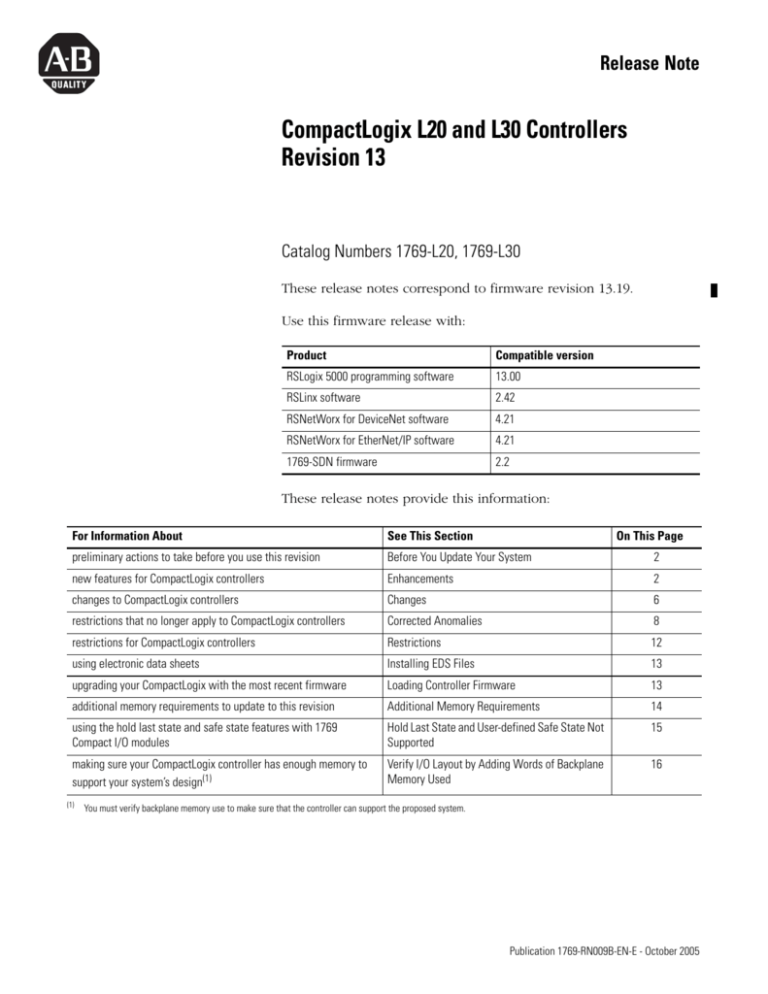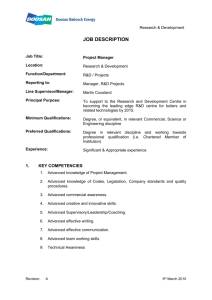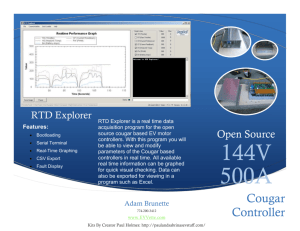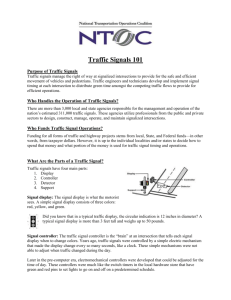
Release Note
CompactLogix L20 and L30 Controllers
Revision 13
Catalog Numbers 1769-L20, 1769-L30
These release notes correspond to firmware revision 13.19.
Use this firmware release with:
Product
Compatible version
RSLogix 5000 programming software
13.00
RSLinx software
2.42
RSNetWorx for DeviceNet software
4.21
RSNetWorx for EtherNet/IP software
4.21
1769-SDN firmware
2.2
These release notes provide this information:
For Information About
See This Section
preliminary actions to take before you use this revision
Before You Update Your System
2
new features for CompactLogix controllers
Enhancements
2
changes to CompactLogix controllers
Changes
6
restrictions that no longer apply to CompactLogix controllers
Corrected Anomalies
8
restrictions for CompactLogix controllers
Restrictions
12
using electronic data sheets
Installing EDS Files
13
upgrading your CompactLogix with the most recent firmware
Loading Controller Firmware
13
additional memory requirements to update to this revision
Additional Memory Requirements
14
using the hold last state and safe state features with 1769
Compact I/O modules
Hold Last State and User-defined Safe State Not
Supported
15
making sure your CompactLogix controller has enough memory to
support your system’s design(1)
Verify I/O Layout by Adding Words of Backplane
Memory Used
16
(1)
1
On This Page
You must verify backplane memory use to make sure that the controller can support the proposed system.
Publication 1769-RN009B-EN-E - October 2005
2
CompactLogix L20 and L30 Controllers Revision 13
Before You Update Your
System
Before you update your controller or RSLogix 5000 software to this
revision, do the following preliminary actions:
If
Then
Your controller is connected to a DH-485
network.
We recommend that you use DH-485 communications as follows:
If you update the firmware of a controller while the controller is connected to a
DH-485 network, communication on the network may stop. To prevent this,
disconnect the controller from the DH-485 network before you update the firmware
of the controller.
Logix5000 controllers should be used on DH-485 networks only when you wish to add
these controllers to an existing DH-485 network. For new applications with
Logix5000 controllers, DeviceNet, Ethernet, and ControlNet are the recommended
networks.
Enhancements
This revision of CompactLogix controllers supports the enhancements
described in Table 1.
Table 1 Enhancements
Enhancement
Description
Consumed Tag Trigger for Event Tasks
An event task performs a function only when a specific event (trigger) occurs. Whenever
the trigger for the event task occurs, the event task:
interrupts any lower priority tasks
executes one time
returns control to where the previous task left off
With the firmware revisions in this publication, the CompactLogix controller event task
trigger can be:
consumed tag
EVENT instruction (also available with FW 12.x)
Online Edits of Sequential Function Charts
(SFC) and Structured Text (ST)
Publication 1769-RN009B-EN-E - October 2005
This revision lets you perform online editing of Sequential Function Chart (SFC) and
Structured Text (ST) routines.
CompactLogix L20 and L30 Controllers Revision 13
3
Table 1 Enhancements
Enhancement
Description
Finalize All Edits in a program
The Finalize All Edits in Program option lets you make an online change to your logic
without testing the change.
Finalize All Edits in Program
When you choose Finalize All Edits in Program:
All edits in the program (pending and test), immediately download to the controller
and begin execution.
The original logic is permanently removed from the controller.
Outputs that were in the original logic stay in their last state unless executed by the
new logic (or other logic).
If your edits include an SFC, the SFC resets to the initial step and stored actions
turn off.
Motion Calculate Slave Value (MCSV)
instruction
Use the MCSV instruction in the following applications:
Position cam: electronic camming between two axes according to a specified cam
profile
Time cam: electronic camming of an axis as a function of time, according to a
specified cam profile
The MCSV instruction returns the slave value within a specified cam profile for a given
master value. The master value can be master position or time. Use that information to
re-synchronize motion after a fault or to calculate dynamic phase corrections.
Publication 1769-RN009B-EN-E - October 2005
4
CompactLogix L20 and L30 Controllers Revision 13
Table 1 Enhancements
Enhancement
Description
Estimate Memory Information Offline
To estimate how much controller memory your project requires, use the Memory tab of the
controller properties dialog box. For each of the memory areas of your controller, the
Memory tab lets you estimate number of bytes of:
View Memory Information Online
free (unused) memory
used memory
largest free contiguous block of memory
When online with a controller, the Memory tab shows the actual memory usage of the
controller. The tab includes a Max Used entry for each type of memory. The Max Used
values show the peak of memory usage as communication occurs.
Improved Performance of Simple Structured
Text Statements
Publication 1769-RN009B-EN-E - October 2005
The controller now executes simple structured text (ST) assignments and comparisons
faster than previous revisions.
For this
This is simple
This is not simple
assignment
A:= B;
A:= -B;
A:= B + C;
A:= sin(B);
comparison (=, <, <=, >, >=, <>)
A>B
A=B
A > -B
A > (B + C)
A > sin(B)
CompactLogix L20 and L30 Controllers Revision 13
5
Table 1 Enhancements
Enhancement
Description
For some non-recoverable faults, the
If the controller detects a non-recoverable fault that was not caused by the controller’s
controller produces a major fault and may be hardware, the controller now responds as follows:
able to log diagnostic information.
If the controller
Then
has a CompactFlash
socket
The controller clears the project from its memory and produces a
major fault (flashing red OK LED)
has no CompactFlash The controller initially shows a solid red OK LED. After you cycle
socket
power, the controller produces a major fault (flashing red OK LED).
In either case, the controller still clears the project from memory. The fault code that the
controller displays depends on whether you have installed a CompactFlash card in the
controller.
Type
Code Cause
1
60
1. Clear the fault.
2. Download the project.
3. Change to Remote Run/Run
mode.
detected a non-recoverable
If the problem persists:
fault
For a controller with no
CompactFlash card installed, the
controller:
cleared the project from
memory
1
61
Recovery Method
1. Before you cycle power to the
controller, record the state of
the OK and RS232 LEDs.
2. Contact Rockwell Automation
support. See the back of this
publication.
1. Clear the fault.
2. Download the project.
3. Change to Remote Run/Run
mode.
detected a non-recoverable
If the problem persists, contact
fault
Rockwell Automation support. See the
wrote diagnostic
back of this publication.
information to the
CompactFlash card
For a controller with a
CompactFlash card installed, the
controller:
cleared the project from
memory
In previous revisions:
The controller would not go to faulted mode or display a fault code for the type of
situation described above.
Controllers with a CompactFlash socket showed a solid red OK LED.
Publication 1769-RN009B-EN-E - October 2005
6
CompactLogix L20 and L30 Controllers Revision 13
Changes
Changes are organized by firmware revision in which the
change occurred.
CompactLogix 1769-L20, 1769-L30 Rev. 13.17
Table 2 Changes
Change
Description
In a Message (MSG) instruction, you Do not set or clear the following members of a Message (MSG) instruction:
cannot set or clear certain status bits.
EW
ER
DN
ST
Flags
Important: If your logic currently manipulates any of the above members of a MSG instruction,
your controller may operate differently when you update to this revision.
If you set or clear one of those bits, RSLogix 5000 software displays the change. But the MSG
instruction ignores the change and continues to execute based on the internally-stored value of
those bits.
Motion planner no longer waits for
consumed data to start flowing
The motion planner now begins execution immediately, regardless of whether or not the planner
is receiving data via a consumed axis.
In previous revisions, a consumed axis caused the motion planner to delay its execution until data
started flowing from the producing controller. Under the following combination of circumstances,
the motion task of the controller failed to start at all:
The system included 2 controllers in the same chassis.
Each controller produced an axis for the other controller.
For Function Block Instructions that
use periodic timing, DeltaT now
includes the fractional portion of the
task’s period
If your function block instruction uses the periodic timing mode, the controller no longer truncates
the fractional portion of a task’s period to produce the delta time (DeltaT).
While in Program mode, a motion
group fault no longer produces a
major fault
As an option, you can configure a motion group to produce a major fault any time the group
detects a motion fault.
In previous revisions, the controller truncated the fractional portion of the task’s period.
With this revision, a motion group that is configured to produce a major fault produces a major
fault only if the controller is in Run/Remote Run mode.
In previous revisions, the motion group could produce a major fault while the controller was in
Program/Remote Program mode. For example, a store to nonvolatile memory interrupts the
execution of the motion planner, which produces a fault.
Publication 1769-RN009B-EN-E - October 2005
CompactLogix L20 and L30 Controllers Revision 13
7
Table 2 Changes
Change
Description
Out-of-range subscript no longer
produces a fault during prescan
During prescan, the controller automatically clears any faults due to an array subscript that is
beyond the range of the array (out of range).
In previous revisions, this produced a major fault.
Autotune now uses a non-integrating
process model for temperature
processes
When you autotune an Enhanced PID (PIDE) function block with the Process Type = Temperature,
autotune now uses a non-integrating process model to estimate tuning constants. This gives
better tuning constants for most application.
In previous revisions, autotune used an integrating process model.
You must place a label (LBL)
instruction at the start of a rung
If your logic includes a Label (LBL) instruction, make sure the instruction is the first instruction on
the rung. If the instruction is not the first, move the LBL instruction to the beginning of the rung.
Otherwise, the routine will not verify.
In previous revisions, RSLogix 5000 software let you place the LBL instruction elsewhere on the
rung. But the controller always executed the instruction as if it were at the beginning of the rung.
Reduction in the prescan time of
projects with many jump to
subroutine (JSR) instructions
During a prescan, the controller no longer prescans a routine more than once. Once the controller
prescans a routine, it does not prescan the routine again during that prescan.
In previous revisions, the controller would prescan a routine as often as the routine was called in
logic. For projects with many calls to subroutines, this could produce a very long prescan and
cause a watchdog timeout fault.
Publication 1769-RN009B-EN-E - October 2005
8
CompactLogix L20 and L30 Controllers Revision 13
Corrected Anomalies
The corrected anomalies are organized by the firmware revision that
corrected them.
CompactLogix 1769-L20, 1769-L30 Rev. 13.19
Table 3 Corrected Anomalies
Anomaly
Description
Controller Occasionally Failed to Load When the controller was powered up, occasionally it did not load its program. An internal check in
Program at Power-Up
the power-up sequence erroneously caused the controller not to load the program.
Lgx00053881
CompactLogix 1769-L20, 1769-L30 Rev. 13.18
Table 4 Corrected Anomalies
Anomaly
Description
Subroutines Invoked from SFC
Actions Were Not Properly
Postscanned
A subroutine invoked from an SFC action was not properly postscanned when the SFC was
configured for automatic reset. Instructions and assignments may not have set their data to
postscan values. For example, an Output Energize (OTE) instruction may not have cleared its data
during postscan.
Lgx00047935
In SFCs Configured for Auto Reset,
Stored Actions Were Not Properly
Postscanned
When an SFC was configured for Automatic Reset and an Action used a stored qualifier (S, SD, SL,
DS), when a reset action (R) executed, the action being reset was not postscanned.
Lgx00047407
CompactLogix 1769-L20, 1769-L30 Rev. 13.17
Table 5 Corrected Anomalies
Anomaly
Description
The controller did not support 32
consumed connections.
Over EtherNet/IP, previous revisions of the CompactLogix controllers supported only 25
connections.
The WallClockTime increased after
power cycles.
When the CompactLogix controllers had power cycled, the controller wallclock time increased.
The WallClockTime changed to an
invalid value after restoring from
CompactFlash at power up.
If you use a CompactFlash card and have it set to “restore on power up,” you may have needed to
reset the wallclock time. If maintaining an accurate wallclock time was crucial to your application,
you either had to disable the “restore on power up” feature or use a combination of GSV and SSV
instructions to check the wallclock time and, if necessary, reset it to an accurate time.
Publication 1769-RN009B-EN-E - October 2005
CompactLogix L20 and L30 Controllers Revision 13
9
Table 5 Corrected Anomalies
Anomaly
Description
uni-directional homing failed to
complete
A Motion Axis Home (MAH) instruction sometime failed to complete (IP bit remained on) under the
following axis configuration:
Return Speed = 0
uni-directional homing (forward or reverse)
unconditional MDR instruction did
not re-execute
A Motion Disarm Registration (MDR) instruction failed to repeatedly execute under the following
circumstances:
You placed the MDR instruction in a structured text routine.
You did not provide any conditions to control the execution of the instruction, that is, you
programmed it to execute continuously.)
In those circumstances, the EN bit might have been left on after the first execution and the
instruction no longer executed again.
Important: In structured text, we recommend that you condition the instruction so that it only
executes on a transition.
Publication 1769-RN009B-EN-E - October 2005
10
CompactLogix L20 and L30 Controllers Revision 13
Table 5 Corrected Anomalies
Anomaly
Description
blended moves produce smoother,
more accurate motion
This revision improves the response of the axes when you blend the execution of Motion
Coordinated Linear Move (MCLM) and Motion Coordinated Circular Move (MCCM) instructions.
If the Termination Type =
command tolerance (2) or no
deceleration (3), axes change
more smoothly and follow the
intended path more closely.
If the Termination Type =
command tolerance (2) or no
deceleration (3) and the
program path direction is
reversed, the instruction will
exceed the specified
acceleration/deceleration for
the MCLM or MCCM
instruction.
Termination Type
0 = actual tolerance
1 = no settle
2 = command tolerance
3 = no deceleration
large message (MSG) instructions
might have caused a non-recoverable
fault
The following configuration of a Message (MSG) instruction might have produced a
non-recoverable fault:
Message type = CIP Data
Table Read or Write
The instruction
transferred > 240 bytes.
Communication was
through the serial port.
When the controller experiences a non-recoverable fault, it clears the project from memory.
during power up, the controller
erroneously showed a red I/O LED
During power up, the controller sometimes showed a flashing red I/O LED when there was no
problem.
autotune produced unnecessary
warnings
When you completed an autotune of an Enhanced PID (PIDE) function block instruction, the
Autotune Status field sometimes showed warning messages that were incorrect (did not apply).
Publication 1769-RN009B-EN-E - October 2005
CompactLogix L20 and L30 Controllers Revision 13
11
Table 5 Corrected Anomalies
Anomaly
Description
Ramp/soak (RMPS) instruction failed
to initialize to the correct mode
On download, a Ramp/Soak (RMPS) Instruction now initializes to Operator Manual mode unless
some other mode is requested.
In previous revisions, the instruction failed to initialize to the correct mode. This lack of
initialization could have caused the RMPS instruction to ignore the soak time for the first
ramp/soak segment.
Remote output module momentarily
dropped its connection
The following combination of circumstances occasionally caused an output module to drop its
connection to the controller and then re-establish the connection:
The module was in a remote chassis.
The module used a Rack Optimization communication format.
The controller also executed a Message (MSG) instruction that bridged across the
backplane of that same remote chassis to another communication module.
Occurred most frequently if the MSG instruction was not cached.
Known Anomalies
The known anomalies are organized by the catalog number in which
they are known to exist.
Table 6 Known Anomalies
Anomaly
Description
Using RPI = 1ms with 1769-L20 and
1769-L30 controllers causes a fault
on the Virtual Adapter.
The RPI range for the CompactLogix Virtual Adapter was changed to allow settings from 1 ms 750 ms for all CompactLogix controller types. Currently the only CompactLogix controllers that
support a 1 ms RPI are the 1769-L31, 1769-L32E, 1769-L35E controllers. The 1769-L20, 1769-L30
controllers support a 2 ms minimum RPI.
You can configure a 1769-L20, 1769-L30 controller project for 1 ms RPI since this appears as a
valid range for the controller and you can download the project without error, but the Virtual
Adapter will be faulted. The fault indicated on the Virtual Adapter Connection tab is “Requested
Packet Interval (RPI) out of range.” The software indicates the setting is valid but the controller
rejects the RPI because it is invalid.
Publication 1769-RN009B-EN-E - October 2005
12
CompactLogix L20 and L30 Controllers Revision 13
Restrictions
The restrictions are organized by the catalog number.
CompactLogix 1769-L20, 1769-L30
Table 7 Restrictions
Restriction
Description
In a tag of a user-defined data
type, an instruction may write
past the end of an array
If you write too much data to an array that is within a user-defined data type, some instructions write
beyond the array and into other members of the tag.
Example 1 Instruction Stops at the End of the Array
If the length is greater than
the number of elements in
the destination array…
…the instruction stops at the
end of the array.
Example 2 Instruction Writes Beyond the Array
If the length is greater than
the number of elements in
the destination array…
…the instruction writes data
beyond the end of the array into
other members of the tag.
Regardless of the length specified
for the instruction, it stops writing
if it reaches the end of the tag.
The following instructions write beyond the array into other members of the tag:
BSL
FBC
LFL
BSR
FFL
LFU
COP
FFU
SQL
CPS
FLL
SRT
DDT
GSV
SSV
This restriction also applies to all previous revisions.
To prevent writing beyond the limits of the destination array, make sure the length operand of the
instruction is less than or equal to the number of elements in the array.
Publication 1769-RN009B-EN-E - October 2005
CompactLogix L20 and L30 Controllers Revision 13
Installing EDS Files
13
If you have RSLinx software, version 2.42 or greater, the most current
EDS files were installed with the software. If you are using an older
version of RSLinx software, you might need to install EDS files. You
need EDS files for:
appropriate controller
1769 CompactBus
1769 local adapter
All of these EDS files, except for the 1769 CompactBus file, are
updated for each firmware revision. There is also a revision 1 of the
EDS files that you need for new controllers. Each controller ships with
revision 1 firmware.
To update the controller firmware, you must have the revision 1 EDS
file 0001000E00410100.eds installed.
The EDS files are available on the CD for RSLogix 5000 Enterprise
Series software, version 13. The files are also available at:
http://www.ab.com/networks/eds.
Loading Controller
Firmware
The controller is shipped without working firmware. You must
download the current firmware before you can use the controller. The
firmware for all CompactLogix controllers is available on the website
and on the RSLogix 5000 CD. To load firmware, you can use:
ControlFlash utility that ships with RSLogix 5000 programming
software.
AutoFlash that launches through RSLogix 5000 software when
you try to open or create a project and the controller does not
have the current firmware.
See the controller installation instructions for more information about
using these utilities to load firmware.
Publication 1769-RN009B-EN-E - October 2005
14
CompactLogix L20 and L30 Controllers Revision 13
Additional Memory
Requirements
Revision 13.0 or later may require more memory than previous
revisions, for example 10.x, 11.x. To estimate the additional memory
that your project may require, use Table 8:
Table 8
If you have this firmware
revision (add all that apply)
Then add the following memory requirements to your project
Component
Increase per instance
12.x or earlier
I/O module with a comm format = Rack Optimization
90 bytes
I/O module with a comm format = something other than Rack
Optimization, that is, direct connection.
144 bytes
CompactLogix 1769 I/O module
170 bytes
bridge module with a comm format = None
160 bytes
bridge module with a comm format = Rack Optimization
220 bytes
tag that uses the MOTION_INSTRUCTION data type
4 bytes
11.x or earlier
tag for an axis
If the data type is
And the tag is
AXIS_VIRTUAL
produced for another controller
264 bytes
not produced for another controller
264 bytes
output cam execution targets
648 bytes
user-defined data type:
128 bytes
number of user-defined data types in the controller organizer Data Types folder User-defined folder
not the use of that data type in tags
(-60 bytes)
indirect address (using a tag as the subscript for an array in an
instruction, for example, Array_A[Tag_B]). This memory change applies
only if the array:
uses a structure as its data type
does not use one of these data types: CONTROL, COUNTER, PID,
or TIMER
has only one dimension, for example, UDT_1[5]
10.x or earlier
programs
12 bytes
routines
16 bytes
Publication 1769-RN009B-EN-E - October 2005
CompactLogix L20 and L30 Controllers Revision 13
Hold Last State and
User-defined Safe State Not
Supported
15
When 1769 Compact I/O modules are used as local I/O modules in a
CompactLogix system, the local I/O modules do not support the Hold
Last State or User-defined Safe State features, even though you can
configure these options in the programming software.
If a local I/O module fails such that the module’s
communication to the controller is lost, or if any module is
disconnected from the system bus while under power, the
controller will go into the fault mode. All outputs turn off when
the system bus or any module faults.
RSLogix 5000 software creates tags for modules when you add
them to the I/O configuration. The 1769 module tags define
configuration (C) data type members that may include attributes
for alternate outputs. CompactLogix does not enable local
modules to use the alternate outputs. Do not configure the
attributes listed below:
For Digital Output Modules
For Analog Output Modules
ProgToFaultEn
CHxProgToFaultEn
ProgMode
CHxProgMode
ProgValue
CHxFaultMode
FaultMode
where CHx = the channel
number
FaultValue
Any 1769 Compact I/O modules used as remote I/O modules in a
CompactLogix system do support the Hold Last State and
User-Defined Safe State features.
Publication 1769-RN009B-EN-E - October 2005
16
CompactLogix L20 and L30 Controllers Revision 13
Verify I/O Layout by Adding
Words of Backplane
Memory Used
Each module in a CompactLogix system uses a set amount of
backplane memory, in addition to the data that the module stores or
transfers. Some modules require a considerable amount of backplane
memory. Take this into account when designing your system because
backplane memory usage affects how many modules a controller can
support. Each CompactLogix controller supports 256, 16-bit words of
backplane data. Table 9 shows how many backplane words each
module uses:
Table 9
Catalog Number
Number of
Modules
1769-IA8I
1769-IA16
1769-IM12
1769-IQ16
1769-IQ32
1769-IQ6XOW4
1769-OA8
1769-OA16
1769-OB8
1769-OB16
1769-OB16P
1769-OB32
1769-OV16
1769-OW8
1769-OW8I
1769-OW16
1769-IF4
1769-IF8
1769-IF4XOF2
1769-OF2
1769-OF8C
1769-OF8V
1769-IR6
1769-IT6
1769-HSC
1769-SDN
system overhead (per
controller)
Total Words Required(1)
(1)
Publication 1769-RN009B-EN-E - October 2005
The total words required cannot exceed 256 words.
Number of Words Used Total Number
8
8
8
8
8
12
12
12
12
12
12
12
12
12
12
12
14
63
20
14
84
84
14
16
187
(35 words input,
34 words output,
118 words configuration)
76
plus total words in scanlist
34
34
CompactLogix L20 and L30 Controllers Revision 13
17
Compact I/O, CompactLogix, Logix5000, RSLinx and RSLogix 5000 are trademarks of Rockwell
Automation, Inc.
Trademarks not belonging to Rockwell Automation are property of their respective companies.
Publication 1769-RN009B-EN-E - October 2005
Rockwell Automation Support
Rockwell Automation provides technical information on the web to assist you in using its products. At
http://support.rockwellautomation.com, you can find technical manuals, a knowledge base of FAQs, technical and
application notes, sample code and links to software service packs, and a MySupport feature that you can customize
to make the best use of these tools.
For an additional level of technical phone support for installation, configuration and troubleshooting, we offer
TechConnect Support programs. For more information, contact your local distributor or Rockwell Automation
representative, or visit http://support.rockwellautomation.com.
Installation Assistance
If you experience a problem with a hardware module within the first 24 hours of installation, please review the
information that's contained in this manual. You can also contact a special Customer Support number for initial help
in getting your module up and running:
United States
1.440.646.3223
Monday – Friday, 8am – 5pm EST
Outside United States
Please contact your local Rockwell Automation representative for any technical support issues.
New Product Satisfaction Return
Rockwell tests all of its products to ensure that they are fully operational when shipped from the manufacturing
facility. However, if your product is not functioning and needs to be returned:
United States
Contact your distributor. You must provide a Customer Support case number (see phone number
above to obtain one) to your distributor in order to complete the return process.
Outside United States
Please contact your local Rockwell Automation representative for return procedure.
Publication 1769-RN009B-EN-E - October 2005 18
Supersedes Publication 1769-RN009A-EN-E - October 2004
PN 957988-53
Copyright © 2005 Rockwell Automation, Inc. All rights reserved. Printed in the U.S.A.









